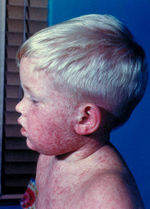Paramyxoviridae: Difference between revisions
| Line 52: | Line 52: | ||
==References== | ==References== | ||
[http://www.ncbi.nlm.nih.gov/ICTVdb/ICTVdB/48000000.htm ICTVdB - The Universal Virus Database, version 3. | [http://www.ncbi.nlm.nih.gov/ICTVdb/ICTVdB/48000000.htm ICTVdB - The Universal Virus Database, version 3.] | ||
[http://www.fleshandbones.com/readingroom/viewchapter.cfm?ID=1130 Murray, Patrick. Medical Microbiology (5th Edition).] | [http://www.fleshandbones.com/readingroom/viewchapter.cfm?ID=1130 Murray, Patrick. Medical Microbiology (5th Edition).] | ||
Revision as of 14:23, 29 June 2006

Baltimore Classification
Higher order taxa
Virus; ssRNA negative-strand viruses; Mononegavirales; Paramyxoviridae
Genera
- Paramyxovirnae (subfamily)
- Avulavirus
- Henipavirus
- Morbillivirus
- Respirovirus
- Rubulavirus
- Pneumovirinae (subfamily)
- Pneumovirus
- Metapneumovirus
Description and Significance

Paramyxoviruses cause a wide variety of well-known illnesses, such as measles, mumps, and parainfluenza (which causes bronchitis, croup, and pneumonia in children). Measles and mumps have only one serotype. Measles ranks with rubella, chicken pox, roseola, and fifth disease as the most common childhood diseases. Though a vaccine for measles, mumps, and rubella was developed in the early 1970s and is used in most industrialized nations (thus significantly reducing the number of cases per year), measles is still one of the most contagious diseases known, causing 30 to 40 million cases and 1 to 2 million deaths per year worldwide in unvaccinated populations. In 1998, two new virulent paramyxoviruses, the hendra and nipah viruses, were isolated in Malaysia and Singapore. (sources: Murray, Pelet, Trayner)
Genome Structure
The paramyxovirus is non-segmented and contains a molecule of linear, negative-sense, single-stranded RNA. Occasionally, virions may also contain a positive-sense, single-stranded copy of the genome. The complete genome is 15200-15900 nucleotides long. The 5'-terminus of the negative-sense strand does not have a covalently attached terminal protein, nor does it have a cap. (source: ICTVdB)
Virion Structure of a Paramyxovirus
Paramyxovirus virions consist of an envelope, a nucleocapsid, and a matrix protein. Virions are large and have a complex construction. They are spherical to pleomorphic, and can range from 150-200nm in diameter and 1000-10000nm long. The envelope has spike-like projections spaced widely apart and evenly covering the surface. The surface projections are embedded in a lipid bilayer. The nucleocapsid is 600-800nm(-1000nm, depending on the genus), 13-18nm in diameter, and has helical symmetry. (source: ICTVdB)
Reproduction Cycle of a Paramyxovirus in a Host Cell

Paramyxovirus replication is very similar to that of other viruses in this group. The overall strategy of paramyxoviruses is very similar to that of influenza, though unlike influenza, all action in the replication of paramyxoviruses occurs in the cytoplasm.
The virions attach to the surface of a host cell, and the envelope fuses to the plasma membrane. The nucleocapsid is released into the cell. The negative-sense RNA is transcribed into individual messenger RNAs and a positive-sense RNA template, which is used to create negative-sense RNA. Assembly occurs, and new viruses bud from the cell membrane (which is how they become enveloped).
Paramyxoviruses have the ability to cause cell-to-cell fusion, creating large multinucleated cells called syncytia.
(source: Murray)
Viral Ecology & Pathology
The ecology and pathology of paramyxoviruses varies greatly between the genera. Parainfluenza viruses and respiratory syncytial virus (RSV) cause respiratory infections, while morbilliviruses (including measles) and mumps virus cause systemic infections. All of the paramyxoviruses are transmitted through the respiratory route. Because of this, they are highly contagious. (sources: , Murray, Trayner)
References
ICTVdB - The Universal Virus Database, version 3.
Murray, Patrick. Medical Microbiology (5th Edition).
Pelet et al. " High throughput screening assay for negative single stranded RNA virus polymerase inhibitors." Journal of Virological Methods 128.1-2 (2005): 29-36.
Trayner, Jennifer. Human Virology at Stanford: Humans and Viruses: Paramyxoviridae (Web Page 1998).
